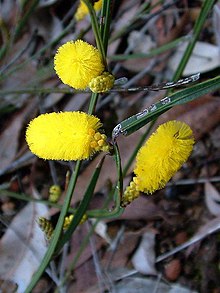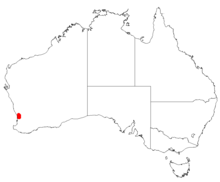| Acacia anomala | |
|---|---|

| |
| Conservation status | |
 Vulnerable (EPBC Act) | |
| Scientific classification | |
| Kingdom: | Plantae |
| Clade: | Tracheophytes |
| Clade: | Angiosperms |
| Clade: | Eudicots |
| Clade: | Rosids |
| Order: | Fabales |
| Family: | Fabaceae |
| Subfamily: | Caesalpinioideae |
| Clade: | Mimosoid clade |
| Genus: | Acacia |
| Species: | A. anomala |
| Binomial name | |
| Acacia anomala C.A.Gardner ex Court | |

| |
| Occurrence data from AVH | |
| Synonyms | |
|
Racosperma anomalum (C.A.Gardner ex Court) Pedley | |
Acacia anomala, commonly known as Chittering grass wattle or grass wattle. is a species of flowering plant in the family Fabaceae and is endemic to a small area along the west coast of Western Australia. It is an erect, rush-like shrub mostly with a few linear to narrow elliptic phyllodes, spikes of golden-yellow flowers, and linear pods up to 50 mm (2.0 in) long.
Description
Acacia anomala has a slender rush-like habit and typically grows to a height of 0.2 to 0.5 metres (0.7 to 1.6 ft). Its upper stems are glabrous and have narrow wings similar to those of Acacia applanata. Its few phyllodes are linear to narrowly elliptic, 40 to 100 millimetres (1.6 to 3.9 in) long and 2 to 6 millimetres (0.08 to 0.24 in) wide, or sometimes absent. Its flowers are borne in spikes, mostly 10–30 mm (0.39–1.18 in) long on a peduncle 1–4 mm (0.039–0.157 in) long and are golden-yellow. There are dark brown bracteoles prominent at the bud stage, but fall off as the flowers open. Flowering occurs in August and September and the pods are linear, crusty, glabrous, up to 50 mm (2.0 in) long and 3–4 mm (0.12–0.16 in) wide with oblong seeds about 2.5 mm (0.098 in) long.
Taxonomy
Acacia anomala was first formally described in 1978 by Arthur Bertram Court in the journal Nuytsia from specimens collected by Charles Austin Gardner and H.H.Kretchmar in 1961 between Muchea and Chittering. The specific epithet (anomala), means 'anomalous' or 'abnormal', because the plant has characteristics of two related species.
In 2003, Leslie Pedley transferred this species to the genus Racosperma as R. anomalum in the journal Austrobaileya, but that name was not recognised by the Australian Plant Census when the dispute regarding the name Acacia was resolved in the International Botanical Congress. (See Acacia.)
Distribution
Chittering grass wattle has a very small range, confined to an area between Chittering, Swan and Kalamunda where it grows on the slopes of the Darling Range in lateritic soils. It is mostly found as part of Eucalyptus woodland communities.
See also
References
- SPRAT (Species Profile and Threats database): Acacia anomala. Retrieved 16 November 2018.
- ^ "Acacia anomala". Australian Plant Census. Retrieved 25 September 2024.
- ^ Maslin, Bruce R. Kodela, Phillip G. (ed.). "Acacia anomala". Flora of Australia. Australian Biological Resources Study, Department of Climate Change, Energy, the Environment and Water: Canberra. Retrieved 25 September 2024.
- ^ "Acacia anomala". FloraBase. Western Australian Government Department of Biodiversity, Conservation and Attractions.
- ^ "Acacia anomala". World Wide Wattle. Western Australian Herbarium. Retrieved 31 August 2018.
- Court, Arthur B. (1978). "Three new species of Acacia (Mimosaceae) from Western Australia". Nuytsia. 2 (4): 168–170. doi:10.58828/nuy00037. Retrieved 25 September 2024.
- "Acacia anomala". Australian Plant Names Index. Retrieved 25 September 2024.
- George, Alex; Sharr, Francis (2021). Western Australian Plant Names and Their Meanings (4th ed.). Kardinya, WA: Four Gables Press. p. 134. ISBN 9780958034180.
- "Racosperma anomalum". Australian Plant Names Index. Retrieved 25 September 2024.
- Pedley, Les (2003). "A synopsis of Racosperma C.Mart. (Leguminosae: Mimosoideae)". Austrobaileya. 6 (3): 450. Retrieved 25 September 2024.
- Smith, Gideon F. & Figueiredo, Estrela (2011). "Conserving Acacia (Mill.) with a conserved type: What happened in Melbourne?". Taxon. 60 (5): 1504–1506. doi:10.1002/tax.605033. hdl:2263/17733.
- "The Acacia debate" (PDF). IBC2011 Congress News. Retrieved May 5, 2016.